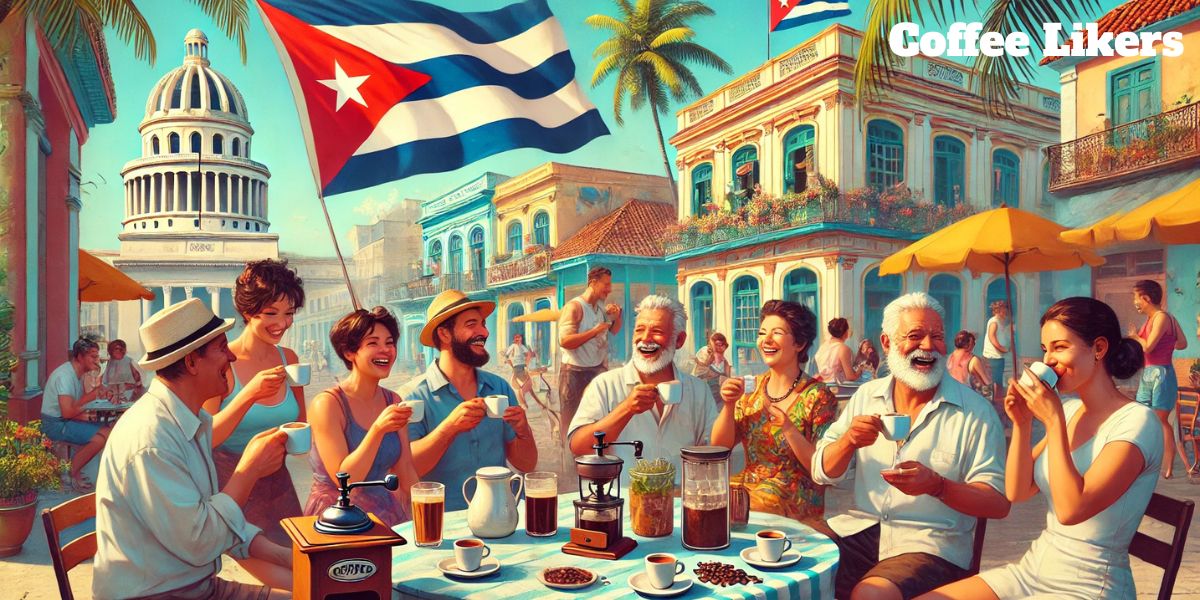Cuban coffee is well-known for its strong flavor and special way of making it, deeply related to Cuban culture. It’s not just a drink, but a symbol of connection and tradition for the community.
The smell of the coffee maker and the sweet taste of a perfectly made cup capture what makes Cuban coffee so special. Exploring the world of Cuban coffee reveals a mix of history, social customs, and a deep love for a good caffeine boost.
Cuban coffee traditions are also important in cultural events and celebrations, showing that it’s more than just a pick-me-up. Whether enjoyed at a party or in quiet moments, Cuban coffee represents the warmth and welcoming spirit of Cuban culture.
Its popularity both locally and globally proves that it’s not just a drink, but a treasured symbol of culture that brings people together. So in this blog, we will look upon the Cuban coffee traditions and its interesting facts and stories!
What are the key components of traditional Cuban coffee preparation? Traditional Cuban coffee is made using dark-roasted coffee beans that are finely ground. People usually brew it in a moka pot. The secret to great Cuban coffee is making the “espuma.” This is done by whisking sugar fast with the first drops of coffee that come from the coffee maker.
Cuban Coffee Traditions: Brief Description
Cuban coffee traditions are an important part of the island’s history and culture. The key components of traditional Cuban coffee preparation include the making and enjoying of “cafecito,” a strong coffee made with sugar.
Coffee came to Cuba in the 18th century and quickly became essential, turning into a valued social habit. People share cafecito in small cups, symbolizing hospitality and connection.
Cuban coffee traditions extend beyond homes and influence daily social life. Friends, family, and coworkers come together to share cafecito, sparking conversations and strengthening relationships.
It is common to see people gathered around a coffee maker, patiently waiting to enjoy the rich aroma and robust flavor that reflect Cuban culture.
Coffee Ritual In Cuba
Coffee is more than just a beverage in Cuba. It is a strong symbol of social ties and cultural tradition. Every part of coffee drinking, from making to enjoying, is an important ritual in Cuban coffee culture.
The key components of traditional Cuban coffee preparation include the wonderful smell of coffee filling the air at sunrise in homes and businesses around the island. This smell invites people to come together.
The bubbling sound of the moka pot signifies the start of a new day. Soon, small cups of strong coffee, often mixed with sweet brown sugar, are shared and savored.
Sharing this “cafecito” is not just about having a drink. It shows hospitality and is a way to connect, celebrating their shared history.
Throughout the day, these Cuban coffee traditions continue, fitting naturally into daily life in Cuba. Whether people take a short break at work or gather with family and friends, making and sharing coffee brings them closer.
It creates a pause in the day, offering time to talk, reconnect, and enjoy each other’s company. These moments are made even better by the shared experience of a well-brewed cup.
Cuban Coffee Ceremony
Think about this: the amazing smell of fresh coffee fills the room. This shows the hard work of the people making it. This is the spirit of the Cuban coffee ceremony, a special moment where time feels slow.
It’s not just about drinking a cup of coffee; it’s about enjoying a tradition that has been passed down through generations. This custom honors life’s small pleasures.
Each cup is made with great care and shows the heart of Cuban tradition. You can hear the moka pot making its rhythmic sound, and the rich smell fills the air. The careful pouring of that dark, sweet drink makes every step part of a special ceremony.
Traditional Cuban Coffee
Traditional Cuban coffee is not just a regular cup of coffee; it’s an experience that wakes up your senses. At the center of it is a strong espresso, made just right, giving it a bold flavor that you can really taste.
What makes it unique is the way brown sugar is added. This sugar is whipped into the first drops of espresso.
This technique is called “espuma” or “espumita.” It makes a creamy layer that rests on top of the rich coffee. This layer adds sweetness and balances the strong flavor of the Cuban espresso.
Social Coffee Drinking In Cuba
In Cuban culture, people value connection and community a lot. Coffee plays a big role in their social lives. Whether in busy city areas or quiet family homes, sharing a small cup of coffee helps strengthen friendships.
Offering a “cafecito” is a kind gesture. It shows warmth and welcome, whether you’re catching up with old friends or greeting a neighbor. This strong coffee is often enjoyed with others, leading to good talks and shared moments.

The Traditional Cuban Coffee-Making Process
Making traditional Cuban coffee is more than simply a way to get your caffeine fix. It involves patience and skill. The main tool used in this process is the “cafetera cubana,” also known as a moka pot.
This stovetop espresso maker is popular for its ability to bring out the strong flavors that are characteristic of Cuban coffee.
To start, you fill the bottom of the moka pot with water, ensuring it is below the pressure valve. Next, add the “canasta,” which is a filter basket filled with finely ground, dark-roasted coffee that you gently press down.
As the water heats up, pressure will build and push the water through the coffee grounds, extracting those bold flavors.
The result is a potent drink known as “cafecito,” which slowly fills the top part of the pot. The rich aroma indicates when it is ready.
The rich and robust culture of Cuban coffee has been preserved via the generations-long use of this traditional coffee-brewing technique.
History And Significance Of Cuban Coffee Traditions
The story of Cuban coffee is both rich and delightful, just like the drink. In the eighteenth century, coffee was introduced to Cuba. It quickly became part of life on the island.
At first, it was seen as a luxury for the wealthy. Soon after, it became available for everyone and became a part of day-to-day Cuban life.
When French settlers came to Cuba in the late 1700s and early 1800s, escaping the Haitian Revolution, they added to the importance of coffee. They shared their skills and traditions. This helped Cuba become known for its coffee production.
Cuban people developed a strong love for coffee. It became more than just a drink; it became an important cultural symbol. The act of sharing a “cafecito,” or a small cup of Cuban coffee, turned into a special ritual.
This act represents hospitality, connection, and shared culture. These traditions remain strong today and show how important coffee is in Cuban history.
Popular Variations Of Cuban Coffee Drinks (Such As Cafecito, Cortadito, And Colada)
Cuban coffee culture has many well-known drinks like cafecito, cortadito, and colada. These drinks are important parts of Cuba’s rich heritage and social life. Cafecito is a strong espresso topped with sweet crema.
Both residents and tourists adore it. Cortadito combines the strong espresso with warm milk, creating a unique taste. Colada is served in small cups for sharing and shows the social aspect of coffee consumption in Cuba.
The Art Of Brewing A Perfect Cup Of Traditional Cuban Coffee
Brewing the perfect cup of traditional Cuban Coffee is a skillful task. It involves using the right techniques and respecting tradition. It all starts with choosing the right beans.
These beans should be finely ground, dark roasted, and usually a mix of Arabica and Robusta. This blend gives the coffee its strong flavor.
Next, the most important step in making the coffee is creating the “espuma.” This creamy layer on top is made by mixing the first drops of espresso from the moka pot with sugar. This whisking technique produces a light and frothy mixture.
Finally, spoon this espuma onto each cup of freshly brewed coffee. It adds sweetness and a smooth texture, making Cuban coffee unique and delightful.

Key Components Of Traditional Cuban Coffee Preparation
To truly enjoy the delicious flavors of traditional Cuban coffee, it’s important to understand what makes it unique.
Let’s start with the coffee beans. They are finely ground, dark-roasted, and often a mix of Arabica and Robusta. The robust flavor of Cuban coffee comes from this blend.
Next is the “espuma.” This is the creamy layer that forms when sugar is mixed with the first drops of brewed coffee. The foamy top adds sweetness and a silky texture, enhancing the overall experience.
Lastly, the brewing equipment plays a crucial role. The moka pot, also known as a cafetera cubana, heats water under pressure.
This process extracts the rich flavors we associate with Cuban coffee. These essential elements, combined with love and tradition, are what make the perfect cup.
The Importance Of Finely Ground Dark Roasted Coffee Beans In Cuban Coffee
Finely ground, dark-roasted coffee beans are very important for making Cuban coffee taste great. The grind and roast affect how the coffee tastes and feels in your mouth.
A fine grind lets the water mix well with the coffee, bringing out rich flavors. Dark roasting releases natural oils in the beans, giving the coffee a full-bodied taste with less acidity.
In Cuba, many people use a moka pot to make coffee. This method needs a fine grind to work well and get the best flavor. When you use the right grind, roast, and brewing method together, you get the strong and delicious coffee that makes Cuban coffee special.
Understanding The Blend Of Arabica And Robusta Beans In Cuban Coffee
Cuban coffee is known for its special mix of Arabica and Robusta beans. Each type adds its traits to the coffee. Arabica has a smooth and fragrant taste. It offers a sweet flavor with hints of chocolate or nuts.
Robusta is famous for its strong, bold taste and has more caffeine. It brings a bitter kick and a lingering aftertaste, which balances the sweet taste of Arabica.
The mix of these beans can change based on what people like and where the coffee comes from. However, it is the careful blend of Arabica’s unique flavors and Robusta’s strength that gives Cuban coffee its rich and complex taste. This shows the skill involved in creating the perfect flavor.
Different Methods Of Brewing Traditional Cuban Coffee At Home
Brewing Cuban coffee at home doesn’t require a trip to Havana. There are various ways to savor those authentic flavors right in your kitchen.
The most common method is to use a “cafetera cubana” or moka pot. This stovetop pot is popular in Cuban households. It uses steam pressure to create strong coffee from finely ground coffee beans.

The Cultural Rituals And Social Aspects Of Enjoying Cuban Coffee
Cuban coffee is more than just a drink; it’s a part of everyday life. It’s a special way to connect with others. Sharing a “cafecito.”
A small, strong cup of Cuban coffee, means more than just getting your caffeine fix. It’s about taking a moment to chat and enjoy time with friends and family.
Whether you’re talking to a neighbor, taking a work break, or gathering with loved ones, the moments spent with Cuban coffee focus on being together.
These times, filled with the aroma of fresh coffee, bring people closer and highlight the importance of social connections in Cuban culture.
Traditional Accompaniments To Cuban Coffee, Such As Pastries Or Desserts
Pairing Cuban coffee with traditional treats makes the experience even better. It mixes sweet and strong flavors. Pastries like guava pastries have a flaky and buttery texture. This contrasts nicely with the strong taste of the coffee.
If you want a lighter choice, try fried plantains with a bit of sugar on top. They have a nice sweet and savory taste. You can also enjoy rich desserts like cream cheese flan. This dessert is creamy and goes well with the rich coffee.
Exploring The Influence Of Cuban Coffee Traditions On Modern Coffee Culture
Cuban coffee traditions are famous for their strong flavors and the connections they bring people. These traditions have had a big impact on modern coffee culture, especially in the United States. Many fancy coffee shops are now open, letting people savor espresso drinks.
One popular drink is the “cortadito.” This is a Cuban coffee drink with a little milk. You can now find it on many menus across the country, showing how Cuban coffee trends are spreading.
There’s also a bigger focus on getting top-quality coffee beans and perfecting brewing methods, showing a move towards enjoying more artisanal coffee.
Pairing Suggestions For Enjoying Cuban Coffee With Traditional Pastries Or Snacks
To make your Cuban coffee experience better, try eating it with tasty snacks. The coffee’s strong flavor goes well with both sweet and savory treats, creating a delicious mix of flavors.
If you like different tastes, try a flaky pastry with sweet guava paste called “pastelitos de guayaba.” It provides a nice contrast to the coffee’s richness.
You might also enjoy a slice of “pan cubano,” a dense and moist bread that often has an anise flavor. It adds a light sweetness and makes a good pairing.

FAQ About Cuban Coffee Traditions
How Do They Drink Coffee In Cuba?
In Cuba, coffee is known as “cafecito.” People usually drink it in small amounts because it has a strong and rich flavor. It is typically served in espresso cups. This coffee is meant to be sipped and enjoyed. It gives a quick boost of energy and a burst of flavor.
Why Is Cuban Coffee Served In Small Cups?
Cuban coffee is made as a strong espresso coffee. It is served in small cups to boost the flavor. The small size lets you drink it quickly while it is hot. This keeps its rich smell and bold taste.
What Are Some Of The Rituals Or Traditions Associated With Coffee?
Coffee is a big part of life in Cuba. People often use a traditional coffee pot to make coffee. They like to share small cups called “cafecitos” with friends and family during the day. This helps to bring them closer together.
What Is The Deal With Cuban Coffee?
Cuban coffee is special because of its unique taste. It has strong espresso coffee and a sweet crema on top. The sweetness comes from mixing sugar with the first drops of brewed coffee. This creates a nice balance with the strong flavor of the espresso.
Final Thought
Cuban coffee is very important to many people, more than just a drink, it represents a special tradition that has been passed down from one generation to the next.
This strong and tasty coffee is not just a morning boost but also carries the history and culture of Cuba. Making and sharing Cuban coffee shows unity, warmth, and togetherness, reflecting the values of community and hospitality in Cuban society.
Cuban coffee traditions have a long history, tied with stories of resilience, creativity, and friendship, from the careful process of making the perfect cup to the happy moments of enjoying its delicious smell and bold flavor.
Each sip tells a story of shared experiences and love. In a fast-paced world, the ritual of drinking Cuban coffee reminds us to take a break, connect with others, and appreciate the simple joys that bring us closer together.





Leave a Reply